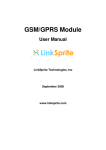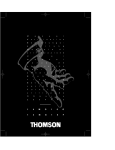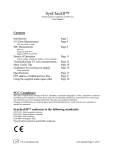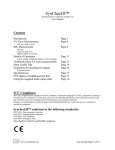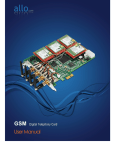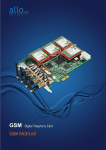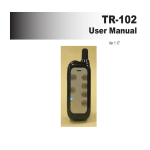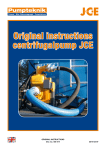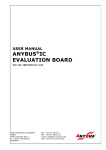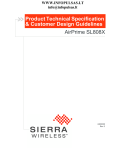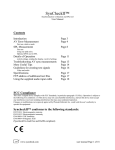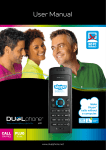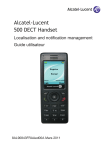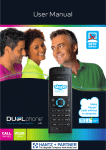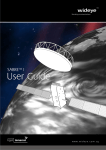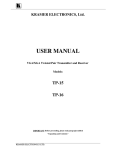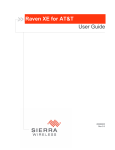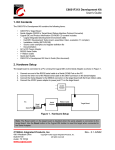Download User`s Manual - Scandinavian Radio Technology AB
Transcript
SRT 346 User’s Manual Version: 1.0 – January 2015 SRT 346 User’s Manual 2 Contents Introduction to SRT 346 .......................................................................................................................... 5 Scope ................................................................................................................................................... 5 General Characteristics ....................................................................................................................... 5 General............................................................................................................................................ 5 Electrical .......................................................................................................................................... 5 Physical ........................................................................................................................................... 5 Interfaces ........................................................................................................................................ 6 Safety Precautions .................................................................................................................................. 7 RF Exposure......................................................................................................................................... 7 General Statement on RF Energy .................................................................................................... 7 Specific Absorption Rate (SAR) ....................................................................................................... 7 Body Worn Operation ..................................................................................................................... 7 Limiting Exposure to Radio Frequency (RF) Fields .......................................................................... 7 Distraction ........................................................................................................................................... 8 Driving ............................................................................................................................................. 8 Operating Machinery ...................................................................................................................... 8 Product Handling ................................................................................................................................ 8 General Statement on Handling and Use ....................................................................................... 8 Small Children ................................................................................................................................. 8 Demagnetisation ............................................................................................................................. 9 Electrostatic Discharge (ESD) .......................................................................................................... 9 Air Bags ........................................................................................................................................... 9 Seizures/ Blackouts ......................................................................................................................... 9 Emergency Calls .............................................................................................................................. 9 Loud Noise ...................................................................................................................................... 9 Phone Heating................................................................................................................................. 9 Electrical Safety ................................................................................................................................... 9 Accessories ...................................................................................................................................... 9 Faulty and Damaged Products ........................................................................................................ 9 Interference ........................................................................................................................................ 9 General Statement on Interference................................................................................................ 9 Pacemakers ................................................................................................................................... 10 Hearing aids .................................................................................................................................. 10 Medical Devices ............................................................................................................................ 10 Hospitals........................................................................................................................................ 10 Aircraft .......................................................................................................................................... 10 Interference in Cars ...................................................................................................................... 10 Explosive Environments .................................................................................................................... 10 Petrol Stations and Explosive Atmospheres ................................................................................. 10 Blasting Caps and Areas ................................................................................................................ 10 Declaration of RoHS Compliance .......................................................................................................... 11 WEEE Notice.......................................................................................................................................... 12 EC DECLARATION OF CONFORMITY ...................................................................................................... 13 Hardware .............................................................................................................................................. 15 Battery & Charger ............................................................................................................................. 15 Battery........................................................................................................................................... 15 Charger .......................................................................................................................................... 15 Battery Level Indicator .................................................................................................................. 16 Low Battery Voltage Detection ..................................................................................................... 17 SIM Card Holder ................................................................................................................................ 17 SRT 346 User’s Manual 3 GSM ................................................................................................................................................... 18 RF Characteristics .......................................................................................................................... 18 Antenna......................................................................................................................................... 18 GSM Status Indicator .................................................................................................................... 18 User Buttons ..................................................................................................................................... 19 On/Off Button ............................................................................................................................... 19 Alarm Button ................................................................................................................................. 19 Call Button..................................................................................................................................... 19 Timer Button ................................................................................................................................. 19 ManDown Button ......................................................................................................................... 19 Function Buttons ........................................................................................................................... 20 Audio ................................................................................................................................................. 21 Microphone & Speaker ................................................................................................................. 21 DTMF ............................................................................................................................................. 21 Vibrator/Buzzer ................................................................................................................................. 21 Vibration Sensor................................................................................................................................ 21 RF Transceiver ................................................................................................................................... 22 RF Status Indicator ........................................................................................................................ 22 RF Antenna .................................................................................................................................... 22 Bluetooth Module ............................................................................................................................. 22 Bluetooth Antenna........................................................................................................................ 22 GNSS .................................................................................................................................................. 23 GNSS Receiver ............................................................................................................................... 23 GNSS Antenna ............................................................................................................................... 23 GNSS Status Indicator ................................................................................................................... 23 SRT 346 User’s Manual 4 Introduction to SRT 346 SRT 346 is a quad-band GSM device equipped with various alarm sensors and a simple, useraccessible interface. It is primarily intended to be placed on car consoles by use of adequately sized, wireless charging capable holder. Thanks to its extremely low power consumption features and portable size, it is perfectly fit to be used on-the-go as a standard personal alarm/tracking device. Scope This document describes general hardware specifications. The product is based on a Sierra Wireless AirPrime™ SL6087 EDGE module which uses a specifically tuned integrated antenna. Device hardware includes MadiaTek based GNSS solution and RF based short-range radio solution for positioning and provides Bluetooth support for wireless communication with manufacturer approved accessories. General Characteristics General Quad-band (850/900/1800/1900 MHZ) EDGE connectivity Class 4 (2W) for GSM 850 and E-GSM Class 1 (1W) for DCS and PCS Fully type approved according to GSM Phase 2+ specifications GPRS multislot class 10 EGPRS multislot class 10 OTA configuration GNSS receiver RF Transceiver for positioning and data transmission as GSM back-up Bluetooth support Wireless charging Electrical Integrated 3.7V Li-ion battery with 2000mAh minimum capacity Maximum 2A peak power consumption during transmission pulses in GSM 900 at 2W 5V DC charge voltage with 750 mA maximum charge current Physical 118x73x26 mm dimensions Weight 160 g Operating temperature: -20°C to +55°C Storage temperature: -35°C to +85°C SRT 346 User’s Manual 5 Interfaces Integrated GSM antenna Integrated GNSS antenna Integrated Bluetooth antenna Man-Down and Timer alarms active status indicators RF tag detection indicator GSM status indicator GPS status indicator Charge/Battery status indicator Easily accessible SIM card holder with 1.8V/3V SIM interface Integrated Li-ion battery On/Off button Alarm button Call button Timer button Five individually programmable function buttons (can be optionally converted to external input contacts) Relay connection External microphone & speaker contacts Integrated vibrator / buzzer Integrated vibration sensor Integrated DTMF decoder Integrated wireless charging circuitry SRT 346 User’s Manual 6 Safety Precautions RF Exposure General Statement on RF Energy Your personal protection device contains a transmitter and a receiver. When it is ON, it receives and transmits RF energy. When you communicate with your personal protection device, the system handling your communication controls the power level at which your personal protection device transmits. Specific Absorption Rate (SAR) Your personal protection device is a radio transmitter and receiver. It is designed not to exceed the limits of exposure to radio waves recommended by international guidelines. These guidelines were developed by the independent scientific organization ICNIRP and include safety margins designed to assure the protection of all persons, regardless of age and health. The guidelines use a unit of measurement known as Specific Absorption Rate, or SAR. The SAR limit for mobile devices is 2.0 W/kg and the highest SAR value for this device was 0.758 W/kg*. As mobile devices offer a range of functions, they can be used in other positions, such as on the body as described in this document. As SAR is measured utilizing the device’s highest transmitting power, the actual SAR of this device while operating is typically below that indicate above. This is due to automatic changes to the power level of the device to ensure it only uses the minimum power required to communicate with the network. Body Worn Operation Important safety information regarding radio frequency radiation (RF) exposure. To ensure compliance with RF exposure guidelines the device must be used with a minimum of 15 mm separation from the body. Failure to observe these instructions could result in your RF exposure exceeding the relevant guideline limits. Limiting Exposure to Radio Frequency (RF) Fields For individuals concerned about limiting their exposure to RF fields, the World Health Organization (WHO) provides the following advice: Precautionary measures: Present scientific information does not indicate the need for any special precautions for the use of mobile phones. If individuals are concerned, they might choose to limit their own or their children’s RF exposure by limiting the length of calls, or using ’hands-free’ devices to keep mobile phones away from the head and body. *The tests are carried out in accordance with the standards EN 50360, EN 62209-1 and EN 62209-2. SRT 346 User’s Manual 7 Distraction Driving Full attention must be given to driving at all times in order to reduce the risk of an accident. Using your equipment while driving causes distraction and can lead to an accident. You must comply with local laws and regulations restricting the use of wireless devices while driving. Operating Machinery Full attention must be given to operating the machinery in order to reduce the risk of an accident. Product Handling General Statement on Handling and Use You alone are responsible for how you use your personal security device and any consequences of its use. You must always switch off your personal security device wherever the use of a mobile phone is prohibited. Use of your personal security device is subject to safety measures designed to protect users and their environment. Always treat your personal security device and its accessories with care and keep it in a clean and dust-free place. Do not expose your personal security device or its accessories to open flames or lit tobacco products. Do not expose your personal security device or its accessories to liquid, moisture or high humidity. Do not drop, throw or try to bend your personal security device or its accessories. Do not use harsh chemicals, cleaning solvents, or aerosols to clean the device or its accessories. Do not paint your personal security device or its accessories. Do not attempt to disassemble your personal security device or its accessories, only authorized personnel must do so. Do not expose your personal security device or its accessories to extreme temperatures. Please check local regulations for disposal of electronic products. Do not carry your personal security device in your back pocket as it could break when you sit down. Small Children Do not leave your personal security device and its accessories within the reach of small children or allow them to play with it. They could hurt themselves or others, or could accidentally damage the device. Your personal security device contains small parts with sharp edges that may cause an injury or which could become detached and create a choking hazard. SRT 346 User’s Manual 8 Demagnetisation To avoid the risk of demagnetization, do not allow electronic devices or magnetic media close to your personal security device for a long time. Electrostatic Discharge (ESD) Do not touch the SIM card’s metal connectors. Air Bags Do not place a personal security device in the area over an air bag or in the air bag deployment area. Store the personal security device safely before driving your vehicle. Seizures/ Blackouts The personal security device can produce a bright or a flashing light. Emergency Calls This equipment, like any wireless phone, operates using radio signals, which cannot guarantee connection in all conditions. Therefore, you must never rely solely on any wireless phone for emergency communications. Loud Noise This equipment is capable of producing loud noises which may damage your hearing. Phone Heating This equipment may become warm during charging and during normal use. Electrical Safety Accessories Use only approved accessories. Do not connect with incompatible products or accessories. Faulty and Damaged Products Do not attempt to disassemble the equipment or its accessory. Only qualified personnel must service or repair the equipment or its accessory. If your equipment or its accessory has been submerged in water, punctured, or subjected to a severe fall, do not use it until you have taken it to be checked at an authorized service center. Interference General Statement on Interference Care must be taken when using the phone in close proximity to personal medical devices, such as pacemakers and hearing aids. SRT 346 User’s Manual 9 Pacemakers Pacemaker manufactures recommend that a minimum separation of 15 cm be maintained between a mobile phone and a pacemaker to avoid potential interference with the pacemaker. To achieve this, use the equipment on the opposite ear to your pacemaker and do not carry it in a breast pocket. Hearing aids People with hearing aids or other cochlear implants may experience interfering noises when using wireless devices or when one is nearby. The level of interference will depend on the type of hearing device and the distance from the interference source, increasing the separation between them may reduce the interference. You may also consult your hearing aid manufacturer to discuss alternatives. Medical Devices Please consult your doctor and the device manufacturer to determine if operation of your equipment may interfere with the operation of your medical device. Hospitals Switch off your wireless device when requested to do so in hospitals, clinics or health care facilities. These requests are designed to prevent possible interference with sensitive medical equipment. Aircraft Switch off your wireless device whenever you are instructed to do so by airport or airline staff. Interference in Cars Please note that because of possible interference to electronic equipment, some vehicle manufactures forbid the use of mobile phones in their vehicles. Explosive Environments Petrol Stations and Explosive Atmospheres In locations with potentially explosive atmospheres, obey all posted signs to turn off wireless devices such as your phone or other radio equipment. Areas with potentially explosive atmospheres include fuelling areas, below decks on boats, fuel or chemical transfer or storage facilities, areas where the air contains chemicals or particles, such as grain, dust or metal powders. Blasting Caps and Areas Turn off your mobile phone or wireless device when in a blasting area or in areas posted turn off ”two-way radios” or ”electronic devices” to avoid interfering with blasting operations. SRT 346 User’s Manual 10 Declaration of RoHS Compliance To minimize the environmental impact and take more responsibility to the earth we live in, this document shall serve as formal declaration that the SRT 346 manufactured by SCANDINAVIAN RADIO TECHNOLOGY AB is in compliance with the Directive 2002/95/EC of the European Parliament – RoHS (Restriction of Hazardous Substances) with respect to the following substances: (1) Lead (Pb) (2) Mercury (Hg) (3) Cadmium (Cd) (4) Hexavalent Chromium (Cr (VI) (5) Polybrominated biphenyls (PBB’s) (6) Polybrominated diphenyl ethers (PBDE’s) (Compliance is evidenced by written declaration from our suppliers, assuring that any potential trace contamination levels of the substances listed above are below the maximum level set by EU 2002/95/EC, or are exempt due to their application.) The SRT 346 manufactured by SCANDINAVIAN RADIO TECHNOLOGY AB, meets the requirements of EU 2002/95/EC. SRT 346 User’s Manual 11 WEEE Notice The Directive on Waste Electrical and Electronic Equipment (WEEE), which entered into force as European law on 13th February 2003, resulted in a major change in the treatment of electrical equipment at end-of-life. The purpose of this Directive is, as a first priority, the prevention of WEEE, and in addition, to promote the reuse, recycling and other forms of recovery of such wastes so as to reduce disposal. 1. When this crossed-out wheeled bin symbol (WEEE logo) is attached to a product it means the product is covered by the European Directive 2002/96/CE. 2. All electrical and electronic products should be disposed of separately from the municipal waste stream via appointed by the government or the local authorities. 3. The correct disposal of your old appliance will help prevent negative consequences for the environment and human health. For more information about electronic and electrical waste equipment disposal, recovery, and collection points, please contact your local city centre, household waste disposal service, shop from where you purchased the equipment, or manufacturer of the equipment. SRT 346 User’s Manual 12 EC DECLARATION OF CONFORMITY The undersigned, representing the following manufacturer Name: Scandinavian Radio Technology AB Address: Box 23 162 11 Vällingby, Sweden Telephone: +46 8 620 2960 Telefax: +46 8 620 2979 herewith declares that the product Type of equipment: Brand name/trade mark: Model/type: Batch/serialnumber: Portable GSM/GPRS/GPS device SRT 346 SRT 346 35919303 000000 to 35919303999999 complies with the essential requirements of Article 3 of the R&TTE 1999/5/EC directive. The following standards have been applied: SRT 346 User’s Manual 13 Reference no EN 60 950-1:2005 EN 60 950-1/A11:2009 EN 301 489-1 V1.8.1 EN 301 489-7 V1.3.1 EN 301 511 EN 50360 (2001-07) EN 62209-1 (2006-03) EN 62209-2 (2010-02) Title R&TTE Directive related to safety R&TTE Directive related to electromagnetic compatibility R&TTE Directive related to efficient use of radio frequency spectrum Human exposure to electromagnetic fields Vällingby 2014-12-01 Tahir Albayrak Managing Director of Scandinavian Radio Technology AB SRT 346 User’s Manual 14 Hardware Battery & Charger Battery SRT 346 includes an integrated rechargeable Li-Ion battery with a nominal voltage of 3.7V and minimum capacity of 2000mAh. The included battery satisfies all the requirements regarding ripple, internal resistance and peak current capacity. The battery in SRT 346 may not be changed or replaced by a user. Charger SRT346 is equipped with a wireless (inductive) charging hardware which provided the benefit of charging without cable connection. Compatible charging station (pad, dock or car holder) is provided with the device. SRT346 can optionally be offered with car charger equipment which is suitable to plug in 12-volt outlet. The charge contact can be found at the bottom of the unit. The charging process is indicated with the Battery Level Indicator and will stop automatically when the battery reaches maximum capacity. If the charger remains connected to the unit or the unit still remains on the charge stand while the unit is running, battery charging will start again when the battery level drops below a certain limit. The charge current is maximum 750mA. For optimal performance, SRT 346 should be charged while in an environment with temperature between 0°C and 45°C. SRT 346 User’s Manual 15 Battery Level Indicator The Battery Level Indicator is a two-colour LED that indicates battery level, charger progress and shutdown progress. Battery Level Indication When no charger is connected and the unit is OFF, the LED will be off. When no charger is connected and the unit is ON, the LED indicates the current battery level with three flashes every 15 seconds as follows: Green-Green-Green: Battery level is good Green-Green-Red: Battery level is fair Green-Red-Red: Battery level is low Red-Red-Red: Battery level is very low Charger Indication When a charger is connected, the Battery Level Indication is suspended in favour of Charger Indication. When charger is connected and the unit is OFF, the LED will flash with a Red light until the charging is complete. When the charging is complete, the LED will stop flashing but will stay Red until either the charger is removed, or charging is needed again. When charger is connected and the unit is ON, the LED will flash with a Green light until the charging is complete. When the charging is complete, the LED will stop flashing but will stay Green until either the charger is removed, or charging is needed again. Shutdown Indication When the unit is turned OFF, the unit indicates that shutdown is in progress by flashing the LED between Red and Green until shutdown is complete, or the unit is turned ON again. Shutdown Indication takes priority over both Charger Indication and Battery Level Indication and the LED will operate normally once the shutdown state is cleared. SRT 346 User’s Manual 16 Low Battery Voltage Detection The battery voltage level is constantly monitored. Aside from the battery level indication, the unit can be put in Low Battery Voltage Mode and No GSM Mode depending on the battery level. Low Battery Voltage Mode SRT 346 enters the Low Battery Voltage Mode when the battery level has been below 3.65V, and a Low Battery Voltage Alarm is generated depending on configuration. To clear the Low Battery Voltage Mode, the battery level must be above 3.80V for 2.5 minutes. While the unit is in low battery mode, all functions work as normal. No GSM Mode SRT 346 enters the No GSM Mode at a battery level of 3.3V, and the unit will shut down. To clear the No GSM Mode, the battery level must be above 3.80V for 4.25 minutes. While in No GSM Mode, all alarms and other functionality is turned off. If there are any pending alarms when the unit enters No GSM Mode, these alarms will be sent when No GSM Mode is cleared. SIM Card Holder A 1.8V/3V SIM Card Reader is integrated in SRT 346. The SIM interface signals are protected by transient voltage suppression diodes to prevent any Electro Static Discharge. The interface is fully compliant with GSM 11.11 recommendations concerning SIM functions. SRT 346 User’s Manual 17 GSM RF Characteristics RF performance is compliant with the ETSI GSM 05.05 recommendation. The main receiver parameters are: GSM850 Reference Sensitivity = -109 dBm E-GSM900 Reference Sensitivity = -109 dBm DCS1800 Reference Sensitivity = -108 dBm PCS1900 Reference Sensitivity = -108 dBm Selectivity @ 200kHz: > +9dBc Selectivity @ 400kHz: > +41dBc Linear dynamic range: 63dB Co-channel rejection: >= 9dBc The main transmitter parameters are: Maximum output power (EGSM & GSM850): 33dBm ± 2dB at ambient temperature Maximum output power (GSM1800 & PCS1900): 30dBm ± 2dB at ambient temperature Minimum output power (EGSM & GSM850): 5dBm ± 5dB at ambient temperature Minimum output power (GSM1800 & PCS1900): 0dBm ± 5dB at ambient temperature Antenna The integrated antenna meets the following requirements: Characteristic E-GSM 900 DCS 1800 GSM 850 TX Frequency 880 to 915 MHz 1710 to 1785 MHz 824 to 849 MHz RX Frequency 925 to 960 MHz 1805 to 1880 MHz 869 to 894 MHz Impedance 50Ω 1.5:1 Rx max VSWR 1.5:1 Tx max 0dBi in at least one direction Typical radiated gain PCS 1900 1850 to 1910 MHz 1930 to 1990 MHz GSM Status Indicator The GSM Status Indicator is a two-colour LED that indicates GSM module status, network coverage and ongoing voice call progress. When the LED is not on, GSM module is powered OFF (Note that SRT 346 may still be ON). When the LED is blinking red, the unit is trying to connect to the GSM network. When the LED is blinking green slowly, the unit is on and ready to process alarms and calls. When the LED is blinking green rapidly, the unit is on and a voice call is in progress. SRT 346 User’s Manual 18 User Buttons SRT 346 button interface provides ten pushbuttons where each one is marked with icons relevant to respective purpose of use. Function buttons labelled from ‘F1’ to ‘F5’ can be optionally converted to external input contacts. On/Off Button SRT346 is turned on or off when On/Off button is pressed and hold for 5 seconds; until device vibrates/beeps once to confirm the input. Alarm Button Alarm Button is made relatively larger for easier access and is used to generate Pushbutton Alarm which can be configured in various ways to depending on the application. The intended usage is to only press this button in case of emergency. Pushbutton can also be used to verify communication between the device and receiver party when the button is pressed five times in a row and the period of each press and release is no more than the actual alarm button detection time. When these requirements are met, all procedures configured for an actual Pushbutton alarm is put in action while the alarm is reported with a different code so that receiver party is made aware that alarm is triggered for test purposes. Call Button With the Call Button a single pre-configured number can be called up. This button is also used to generate a Status Check Alarm if call button function is not enabled. Timer Button Timer (Passivity) alarm is used to report situations of when user becomes unable to interact with the device after a specified period of time expires. Timer button activates or deactivates Timer alarm monitoring when pressed and hold for 5 seconds longer than specified period of time for call button detection. Once Timer alarm monitoring is active, Timer button is used to buy time (i.e. restart timer countdown) when pressed and hold for the specified period of time for call button detection. Timer alarm active status is indicated by the yellow LED that is placed above Timer button. The LED rapidly flashes 5 times to confirm function activation or deactivation. It also flashes every second as long as Timer alarm monitoring stays in progress. The function will also be de-activated when the unit is turned off, the unit enters low battery mode and when connected to charger in some modes. ManDown Button ManDown alarm is used to report situations of when user becomes injured or unconscious by constantly monitoring up-right position of body posture. ManDown button activates or deactivates ManDown alarm monitoring when pressed and hold for 5 seconds longer than specified period of time for call button detection. SRT 346 User’s Manual 19 ManDown alarm active status is indicated by the yellow LED that is placed above ManDown button. The LED rapidly flashes 5 times to confirm function activation or deactivation. It also flashes every second as long as ManDown alarm monitoring stays in progress. The function will also be de-activated when the unit is turned off, the unit enters low battery mode and when connected to charger in some modes. Function Buttons There are five generic function buttons with configurable detection time and detection method. Each button can be individually configured to control built-in relay operation and generates a unique alarm code which specifies the button pressed. Active status of function buttons when configured in toggle mode is indicated by flashing green LEDs placed above each button. Button inputs can also be wired in order to be used as external contacts for the purpose of generating alarms by various input methods depending on how the contacts are installed. Relay Built-in relay can be activated or de-activated either automatically by preset configuration for when specified function button status changes or manually by upon reception of respective action commands via SMS. SRT 346 User’s Manual 20 Audio Microphone & Speaker SRT346 can optionally be equipped with external microphone and speaker. DTMF SRT 346 has a built-in DTMF decoder that can be used to authenticate the receiver of an alarm call. Vibrator/Buzzer SRT346 can be equipped with either a buzzer or a vibrator which is used to indicate various events, such as: Incoming Voice Call and SMS Button input detection Alarm Report transmission success Alarm Call connect success Connection hang-up after successful Alarm Call Vibration Sensor The Vibration Sensor can be used to generate alarms in case of vibration or no-vibration, as well as be used for battery savings operations. When used for battery savings operations, no Vibration Sensor Alarms will be generated and the unit will enter idle mode after a time when no vibrations are detected at all. SRT 346 User’s Manual 21 RF Transceiver In addition to GNSS based positioning, SRT346 provides the possibility to enhance positioning methods thanks to the built-in RF module operating on ISM band. Same module can be used to receive user-defined position messages broadcasted by SRT manufactured RF tags (SRT334) as well as transmit alarm reports in lack of GSM network connection. RF Status Indicator The RF Status Indicator is a green LED that indicates if the unit is in contact with a RF tag (SRT334). When the LED is not on, the radio module is either turned off or there is no RF tag nearby. When the LED is flashing, the unit is effectively in contact with a RF tag (SRT334). RF Antenna General characteristics: Frequency Range Radiation Efficiency Peak Gain VSWR Polarization : 2400-2500 MHz > 70% >2 dBi <2:1 :Linear Bluetooth Module Bluetooth support applies to SRT approved Bluetooth accessories only. General characteristics are as follows: Fully embedded Bluetooth® v3.0 Class 2 module 128-bit encryption security FCC and Bluetooth® qualified Multipoint capability Bluetooth Antenna General characteristics: Sensitivity level BER < .001 with DH5 -86 dBm Maximum usable level BER < .001 with DH1 0 dBm Input VSWR 2.5:1 Maximum output power 50 ohm load 0 dBm Initial carrier frequency tolerance 0 kHz 20 dB bandwidth for modulated carrier 935 kHz SRT 346 User’s Manual 22 GNSS GNSS Receiver General characteristics: GPS, GALILEO, QZSS: L1 1575.42MHz, C/A code GLONASS: L1 1598.0625MHz ~ 1605.375MHz, C/A code Support 99 channels (33 Tracking, 99 Acquisition) Acquisition Time (Hot start, Open Sky): 1s (typical) Acquisition Time (Cold start, Open Sky): 33s (typical) Position Accuracy: 2.5m CEP GNSS Antenna General characteristics: Patch antenna Right Hand Circular Polarization Frequency Range – 1575.42MHz ± 1.023MHz Gain – -1.5dBic Typ. @zenith Axial ratio – Max 4.0dB @zenith GNSS Status Indicator The GPS Status Indicator is a green LED that indicates if the unit has a current GPS position. When the LED is not on, the GPS is either turned off or it has no current GPS position. When the LED is flashing, the unit has a current GPS position. SRT 346 User’s Manual 23

























